|
Tucson Audubon Society
April 26, 2024
View email online
| |
 Welcome, Jo, to Tucson Audubon's weekly update. Welcome, Jo, to Tucson Audubon's weekly update.
In how many backyards in the US can you watch an adult Western Yellow-billed Cuckoo catch prey and then go and feed it to a young bird? Tucson Audubon's Paton Center for Hummingbirds is one of those yards, and I had the pleasure of watching that today. Do pay a visit sometime soon and experience the magic of Patagonia. You'll find volunteer opportunities and events at the Center below.
As well as sharing the joy of birding, Tucson Audubon also pays special attention to keeping our members keyed into national issues related to birds. We know that as our climate changes it affects the suitability of places for birds and they will seek other areas that suit their requirements of temperature, rainfall, and seasonal changes. This week sees the release of a report from National Audubon that predicts future ranges of birds based on a model that integrates species needs with the predicted future conditions of a changing climate.
In addition, this week sees the release of the State of the Birds 2014 report that uses information from the Christmas Bird Count and the Breeding Bird Survey to track population trends within different habitats of North America. The State of the Birds report uses birds as indicators of ecosystem health by examining population trends of obligate species for a series of habitats. You can read about both reports below.
This Saturday sees the dedication of the Grand Canyon Global Important Bird Area, as part of the Park's annual Wildlife Day. There's a link to more details below.
We have some new courses on offer to help you learn more about birds with local teachers, and many opportunities to volunteer your time and expertise.
You'll find some key conservation issues related to birds and birding below, so please read and take action as you can, including thanking some of our elected representatives (and telling others why you disagree with their vote). And if you ever wondered what "virtual sugar" might be, just scroll down to the section on our Paton Center.
And finally, this week we close out our special Summer Appeal. Your special summer gift will help people learn how to create bird-friendly oases in their yards and bring more native habitat back into our community. Read our full letter and also get your fast Wilson's Warbler facts. One single gift of $2000 would complete our appeal today! Can you do that for our birds?
Thank you for sharing your love of birds, birding, and the places they live through Tucson Audubon.


Birds and Climate Change
A report from National Audubon released yesterday models how our changing climate could affect the ranges of 588 North American birds. Using information from the Christmas Bird Count and the North American Breeding Bird Survey to define the range of conditions each species needs to survive, and future greenhouse gas emissions scenarios, they mapped where each bird’s ideal climatic range may be found in the future as the climate changes.
Of the 588 bird species modeled, 314 species would lose more than one half of their current climatic range by 2080 if global warming continues at its current pace. Of these,126 would lose more than half of their current range by 2050. Some species ranges will shift or even expand.
The study covers Alaska, Canada, and the lower 48 states: there is insufficient data to study the effects of global warming on birds that winter in Latin America. The model does not include factors such as sea-level rise, prey base, species competition, and the complexities of ecology, such as inter-species competition in the new ranges, it simply identifies which species are most sensitive to the projected change in the near future.
The National Audubon site features animated maps that show the probability of a bird occurring at a location based on the climate in the area in three future time periods (2020, 2050, and 2080). Perhaps most useful are the Venn diagrams for each species, where the size of the circles indicates the species’ range size in 2000 and 2080, and the amount of overlap between the circle indicates geographic range stability: Lots of overlap means little shift and no overlap indicates the species will leave its current range entirely.
Take a look at the Gilded Flicker here for example. You can also read an overview of the study at the National Audubon website.
The State of the Birds 2014
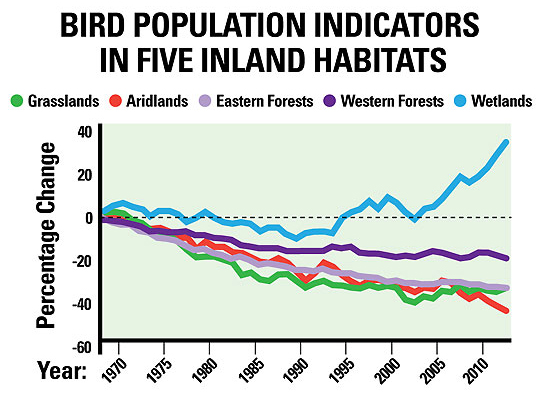
The 2014 State of the Birds assesses the health of our nation’s bird populations through a set of habitat indicators, a Watch List of species most vulnerable to extinction, and a list of the Common Birds in Steep Decline. Habitat indicators are based on the population changes of obligate bird species—those birds restricted to a single habitat—where long-term monitoring data is available. This year’s indicators repeat the method from the original 2009 State of the Birds.
Last Days to Support Tucson Audubon's Summer Appeal!
This week we draw to a close our Summer Appeal. Tucson Audubon thanks 188 generous individuals who came together to nearly reach our $25,000 goal. Together, you raised more than $23,000 to support birds like the Wilson's Warbler, and the unique habitats on which they depend. As the summer concludes and fall begins, we will work with you as a voice for our birds, habitats, and people of our special region. Thank you.
We know there is one generous donor who will help us reach our goal with a $2000 gift this week!

We Have a New Line Up for the Fall
Feeling the urge to plant, beautify you yard and create habitat for birds?
Have you taken Moving To Mastery? This course is the perfect follow-up.
Take birding beyond species ID to deepening your connection with nature.
Find details and register online by clicking on the course name. For questions, contact Bete Jones.
Image by Glenn Butler
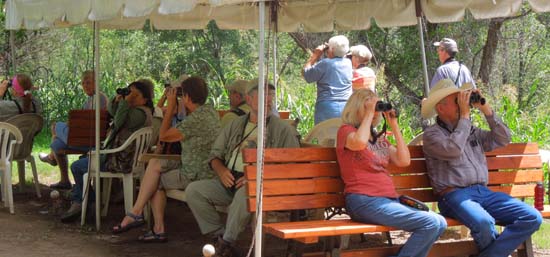
What Are Folks Seeing These Days at the Paton Center?
In addition to the fall migrants, some new permanent residents you can expect soon in the backyard at the Paton Center for Hummingbirds are: three more versatile "flip" benches, a new canopy, an overhaul of the seed feeders, a large bird checklist sign, and a new (shiny!) donation box. Wouldn't you like to help us fund these improvements? Soon enough we'll fill you in on bigger changes for the front yard.
Meanwhile, stay tuned and stay true to the Virtual Sugar Fund by making your donation at: tucsonaudubon.org/paton.
Needed: Volunteers to Help With Paton Casita Renovation Next Week
If you would be available next week Wed, Thurs., or Fri. (Sept. 17, 18, or 19) to travel to the Paton Center and help with priming and painting the inside of the casita, please contact Keith, the Paton Center Coordinator
Call for carpenters
We’re seeking volunteer carpenters for a few projects:
- Help restore two antique benches from the Paton Center.
- Join our crew of nest box builders to support our Win-Win for Azure Bluebirds and Arizona Vineyards conservation project to expand the breeding territory of the Azure Bluebird into the Sonoita Grasslands
- Volunteer at the Western Institute for Leadership Development (WILD) high school “MakerSpace” (shop class) to guide students building American Kestrel and Western Screech Owl boxes for the Tucson Audubon Nature Shop. To find our more about this project, contact Keith and read his blog post.
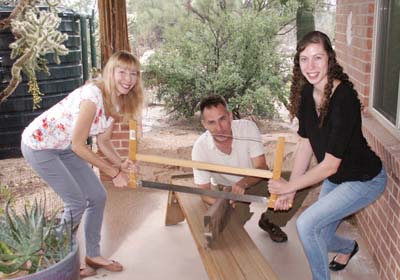 Bring our carpentry to the modern era Bring our carpentry to the modern era
We now have numerous projects for which, as you can see, we need better tools. If you’ve got a table saw or compound miter saw laying around collecting dust instead of producing sawdust, consider donating it to us.
Or, maybe help us buy a new one… Contact Jonathan.

Birding Opportunities Continue This Fall
September 13 | Saturday 5:30 am
St. David and Willcox
Mid-September usually offers plenty of birds and occasional pleasant
surprises. We will begin in the riparian habitat in St. David in the
relative cool of the morning. We will be walking a mile or two over
mostly level ground. Then we head to the Willcox ponds to see what
shorebirds are migrating through. We may stop at the Benson ponds on
our return to Tucson (by mid-afternoon). Meet at Houghton Road, just north of I-10 (about 180 miles
round trip). You must register online.
Leader Dave Dunford. Contact Dave with questions, 520-909-1809
ddunford@dakotacom.net
November 1 | Saturday 8 am
Sabino Canyon
We'll
bird Sabino Canyon Recreation Area walking a loop that includes both
Sonoran desert uplands and Sabino Creek riparian areas. The 4-mile walk
includes rocky uneven trails. Meet at the ramada by the Visitor's Center
at 5700 N Sabino Canyon Road. $5 parking fee. Return by noon. Leaders are Sabino Canyon Volunteer
Naturalists. Limit 15 participants. You must register online.
Leaders: Jean & Mark Hengesbaugh, contact with questions
jhhenge@yahoo.com

Grand Canyon IBA Dedication This Saturday!
Grand Canyon National Park Dedicated as Global Important Bird Area on Saturday
This Saturday our very own world famous Grand Canyon National Park will be dedicated as a Global Important Bird Area. This event is the headliner event for the park's very popular annual Wildlife Day. HawkWatch International will be doing migrant raptor surveys open to the pubic and there will be free bird walks. The Global IBA Dedication Ceremony will be at 1:30pm at Yaki Point.
Image by Chris Richards.
Good for the Planet, Good for the Birds!
 We've all seen the devastation off shore oil contamination has on coastal bird habitats. That's why Tucson Audubon Society's Nature Shop is proud to now carry Bird Project Soap. Each black, bird shaped soap contains a white, ceramic bird, handmade from Louisiana Clay, which remains as a keepsake once the outer soap has washed away. Through the daily act of washing, you will eventually free the clean, white, ceramic birds inside - potent symbols of restoration and recovery. The soap is shaped to be cradled in your hand and is a powerful representation of all creatures affected by the BP Deepwater Horizon Oil Spill Disaster. The soaps are made with natural, locally sourced ingredients: biodiesel glycerin, fair trade olive oil, aloe, activated black charcoal, and a light cypress scent - reminiscent of Louisianan bayous. They are made by Emily Manger Davis of Sweet Olive Soaps, a third generation soapmaker from New Orleans. 50% of profits go to environmental cleanup and care for affected animals of the BP Deepwater Horizon Oil Spill Disaster (Gulf Restoration Network & IBRRC). $21,000 donated and counting, thanks to all of your wonderful support! We've all seen the devastation off shore oil contamination has on coastal bird habitats. That's why Tucson Audubon Society's Nature Shop is proud to now carry Bird Project Soap. Each black, bird shaped soap contains a white, ceramic bird, handmade from Louisiana Clay, which remains as a keepsake once the outer soap has washed away. Through the daily act of washing, you will eventually free the clean, white, ceramic birds inside - potent symbols of restoration and recovery. The soap is shaped to be cradled in your hand and is a powerful representation of all creatures affected by the BP Deepwater Horizon Oil Spill Disaster. The soaps are made with natural, locally sourced ingredients: biodiesel glycerin, fair trade olive oil, aloe, activated black charcoal, and a light cypress scent - reminiscent of Louisianan bayous. They are made by Emily Manger Davis of Sweet Olive Soaps, a third generation soapmaker from New Orleans. 50% of profits go to environmental cleanup and care for affected animals of the BP Deepwater Horizon Oil Spill Disaster (Gulf Restoration Network & IBRRC). $21,000 donated and counting, thanks to all of your wonderful support!
Stop by our Nature Shop today and pick one up for yourself or someone you care about. Bird Project Soap, the gift that keeps on giving.
65 Years of Swarovski Sale
Tucson
Audubon's Nature Shops are the best place in our region to try and buy
binoculars. Check out our
prices and you can see why. Come in and see us for
the top brands.
Need directions to
our Nature Shops? Find all the info here.

Conservation News
News related to the
accelerating global warming crisis has captured the headlines this week. Today
the World Meteorological Organization (WMO) released its annual Greenhouse Gas Bulletin, announcing that “The amount of
greenhouse gases in the atmosphere reached a new record high in 2013, propelled
by a surge in levels of carbon dioxide.” It is not surprising then that 2013 tied with 2003 as the fourth
warmest year on record,
and May of this year was the warmest in
recorded history. Today’s
announcement from WMO has “injected even greater urgency into the need for
concerted international action against accelerating and potentially devastating
climate change.”
Disruption: Educate Your Friends About Climate Change
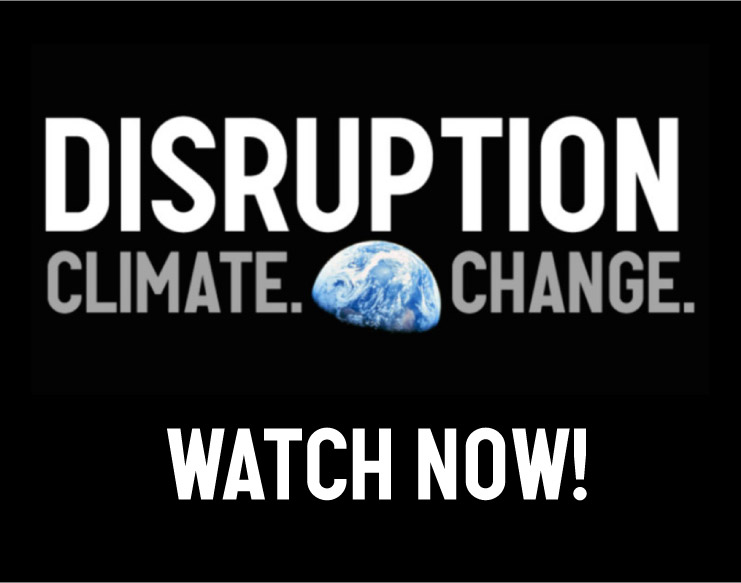 Disruption is a short film about how we can change the world -- before the fossil fuel industry irreversibly changes the climate. It looks at how social movements of the past mobilized at decisive moments to shift the course of history, and applies those lessons to the decisive fight of this generation. Disruption is a short film about how we can change the world -- before the fossil fuel industry irreversibly changes the climate. It looks at how social movements of the past mobilized at decisive moments to shift the course of history, and applies those lessons to the decisive fight of this generation.
It features author and filmmaker Naomi Klein, CNN host and movement leader Van Jones, MSNBC's Chris Hayes, plus many more, including some of the key scientific voices sounding the alarm.
Here’s the most exciting part of this story: it’s not finished yet. The next act will be written in the streets on September 21st, when the People's Climate March takes over Tucson, New York (and cities across the globe).
This is the history we'll tell the next generation -- about the end of fossil fuels, about how the world was in crisis, about how we started to turn it around together. Forward your friends the link to watch the film.
Arizona Representatives Stop EPA and ACE From Doing Their Jobs
We regret we are unable to thank seven Representatives from
Arizona who voted against the environment yesterday. They voted for HR 5078 that prevents the
Environmental Protection Agency (EPA) and the Army Corps of Engineers (ACE) from doing their jobs in a professional, science based
manner, and against the intent of the Clean Water Act.
We are pleased to report, however, that Representatives Raul Grijalva and Ed Pastor voted against HR 5078 in an effort to protect the intent of the Clean Water Act and the health and functions of our watersheds.
Thank you Congressmen Grijalva and Pastor!
HR 5078 prohibits the Environmental Protection Agency (EPA) or Army Corps of Engineers (ACE) from finalizing, implementing, or enforcing the new Waters of the US Proposed Rule which seeks to clarify a previously controversial and confusing court ruling (the public comment period for the new proposal ends October 20, 2014); prohibits the EPA or ACE from using the best available scientific information from the current Rule proposal as the basis for any future Rule; and requires EPA and USACE to work with state and local authorities to develop piecemeal recommendations for the scope of a Waters of the US rule and then issue a report of their findings.
To say the least, this will make the job of serving the public’s interests in administrating impacts to Waters of the US less consistent and much more difficult and cumbersome.
Dates For Your Calendar
Wednesday, Sept. 10 from 5:30 p.m. to 8 p.m.
Center for Biological Diversity is pleased to invite you to join our Executive Director Kierán Suckling and Population Media Center's President Bill Ryerson for a free lecture on human population growth.
Where: Center for Creative Photography, 1030 North Olive Road, Tucson. Click here to RSVP
and get more information.
Wednesdays Sweetwater Wetlands Bird Walk. Join Mike S. for an easy walk through the wetlands to see waterfowl, regular and visiting warblers, and several exciting species hiding in the reeds. Birders of all experience levels welcome! Contact leader for start time and to sign up, mike.sadat@gmail.com .
Every Thursday! Wake Up With the Birds at Agua Caliente Park. Explore the ponds and Molino Basin occasionally. FREE. Call 615-7855 for meeting time or see tucsonaudubon.org/fieldtrips.html.
February 10, 2015 Tucson Audubon's Seventh Annual Gala. An Evening for the Birds: Bringing Nature Home. Featuring Brad Lancaster. Oasis Tucson:Transforming Mirage to Reality. Sponsorship details from Kara Kaczmarzyk
Thank you, Jo, for being a part of Tucson Audubon and helping to protect birds, other wildlife, and the places they live in southeast Arizona for future generations. Thank you for making a gift during the final week of this summer's appeal to support the work of restoring natural habitats for birds and for people.
Sincerely,
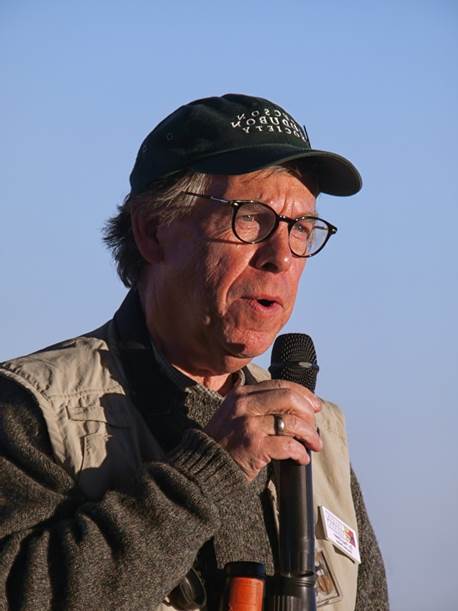 
Dr. Paul Green
Executive Director | Tucson Audubon
Connecting
people with birds & the places they live
  
Plain-capped Starthroat banner by Bryan Holliday
|
| |
|
|
|
Email Marketing By
|


|
|
|
|
